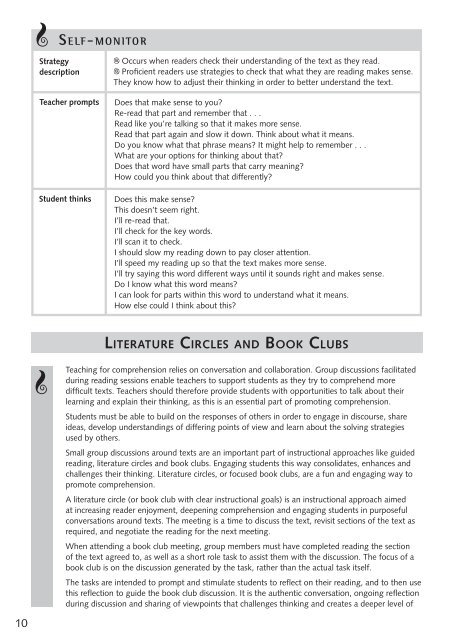All You Need To Teach Comprehension 10+
Create successful ePaper yourself
Turn your PDF publications into a flip-book with our unique Google optimized e-Paper software.
S e lf-mon ito r<br />
Strategy<br />
description<br />
<strong>Teach</strong>er prompts<br />
Student thinks<br />
@ Occurs when readers check their understanding of the text as they read.<br />
@ Proficient readers use strategies to check that what they are reading makes sense.<br />
They know how to adjust their thinking in order to better understand the text.<br />
Does that make sense to you?<br />
Re-read that part and remember that . . .<br />
Read like you’re talking so that it makes more sense.<br />
Read that part again and slow it down. Think about what it means.<br />
Do you know what that phrase means? It might help to remember . . .<br />
What are your options for thinking about that?<br />
Does that word have small parts that carry meaning?<br />
How could you think about that differently?<br />
Does this make sense?<br />
This doesn’t seem right.<br />
I’ll re-read that.<br />
I’ll check for the key words.<br />
I’ll scan it to check.<br />
I should slow my reading down to pay closer attention.<br />
I’ll speed my reading up so that the text makes more sense.<br />
I’ll try saying this word different ways until it sounds right and makes sense.<br />
Do I know what this word means?<br />
I can look for parts within this word to understand what it means.<br />
How else could I think about this?<br />
Literature Circles and Book Clubs<br />
<strong>Teach</strong>ing for comprehension relies on conversation and collaboration. Group discussions facilitated<br />
during reading sessions enable teachers to support students as they try to comprehend more<br />
difficult texts. <strong>Teach</strong>ers should therefore provide students with opportunities to talk about their<br />
learning and explain their thinking, as this is an essential part of promoting comprehension.<br />
Students must be able to build on the responses of others in order to engage in discourse, share<br />
ideas, develop understandings of differing points of view and learn about the solving strategies<br />
used by others.<br />
Small group discussions around texts are an important part of instructional approaches like guided<br />
reading, literature circles and book clubs. Engaging students this way consolidates, enhances and<br />
challenges their thinking. Literature circles, or focused book clubs, are a fun and engaging way to<br />
promote comprehension.<br />
A literature circle (or book club with clear instructional goals) is an instructional approach aimed<br />
at increasing reader enjoyment, deepening comprehension and engaging students in purposeful<br />
conversations around texts. The meeting is a time to discuss the text, revisit sections of the text as<br />
required, and negotiate the reading for the next meeting.<br />
When attending a book club meeting, group members must have completed reading the section<br />
of the text agreed to, as well as a short role task to assist them with the discussion. The focus of a<br />
book club is on the discussion generated by the task, rather than the actual task itself.<br />
The tasks are intended to prompt and stimulate students to reflect on their reading, and to then use<br />
this reflection to guide the book club discussion. It is the authentic conversation, ongoing reflection<br />
during discussion and sharing of viewpoints that challenges thinking and creates a deeper level of<br />
10


















